window MAZDA MODEL 3 HATCHBACK 2020 (in English) User Guide
[x] Cancel search | Manufacturer: MAZDA, Model Year: 2020, Model line: MODEL 3 HATCHBACK, Model: MAZDA MODEL 3 HATCHBACK 2020Pages: 598, PDF Size: 89.37 MB
Page 73 of 598

Never use a rear-facing child-restraint
system in the front seat with an air bag
that could deploy:
Rear-facing child-restraint systems on the
front seat are particularly dangerous even
though you may feel assured that a front
passenger air bag will not deploy based on
the fact that the front passenger air bag
deactivation indicator light illuminates.
The child-restraint system can be hit by a
deploying air bag and moved violently
backward resulting in serious injury or
death to the child.
Do not sit too close to the driver and front
passenger air bags:
Sitting too close to the driver and front
passenger air bag modules or placing
hands or feet on them is extremely
dangerous. The driver and front passenger
air bags inflate with great force and speed.
Serious injuries could occur if someone is
too close. The driver should always hold
onto only the rim of the steering wheel. The
front seat passenger should keep both feet
on the floor. Front seat occupants should
adjust their seats as far back as possible
and always sit upright against the
seatbacks with seat belts worn properly.
Sit in the center of the seat and wear seat
belts properly:
Sitting too close to the side air bag modules
or placing hands on them, or sleeping up
against the door or hanging out the
windows is extremely dangerous. The side
and curtain air bags inflate with great force
and speed directly expanding along the
door on the side the car is hit. Serious injury
could occur if someone is sitting too close
to the door or leaning against a window, or
if rear seat occupants grab the sides of the
front seatbacks. Give the side and curtain
air bags room to work by sitting in the
center of the seat while the vehicle is
moving with seat belts worn properly.
Do not attach objects on or around the
area where driver and front passenger air
bags deploy:
Attaching an object to the driver and front
passenger air bag modules or placing
something in front of them is dangerous. In
an accident, an object could interfere with
air bag inflation and injure the occupants.
Do not attach objects on or around the
area where a side air bag deploys:
Attaching objects to the front seat in such a
way as to cover the outboard side of the
seat in any way is dangerous. In an
accident the object could interfere with the
side air bag, which inflates from the
outboard side of the front seats, impeding
the added protection of the side air bag
system or redirecting the air bag in a way
that is dangerous. Furthermore, the bag
could be cut open releasing the gas.
Essential Safety Equipment
SRS Air Bags
2-57
Mazda3_8HZ1-EA-19G_Edition1_old 2019-5-17 13:49:03
Page 74 of 598
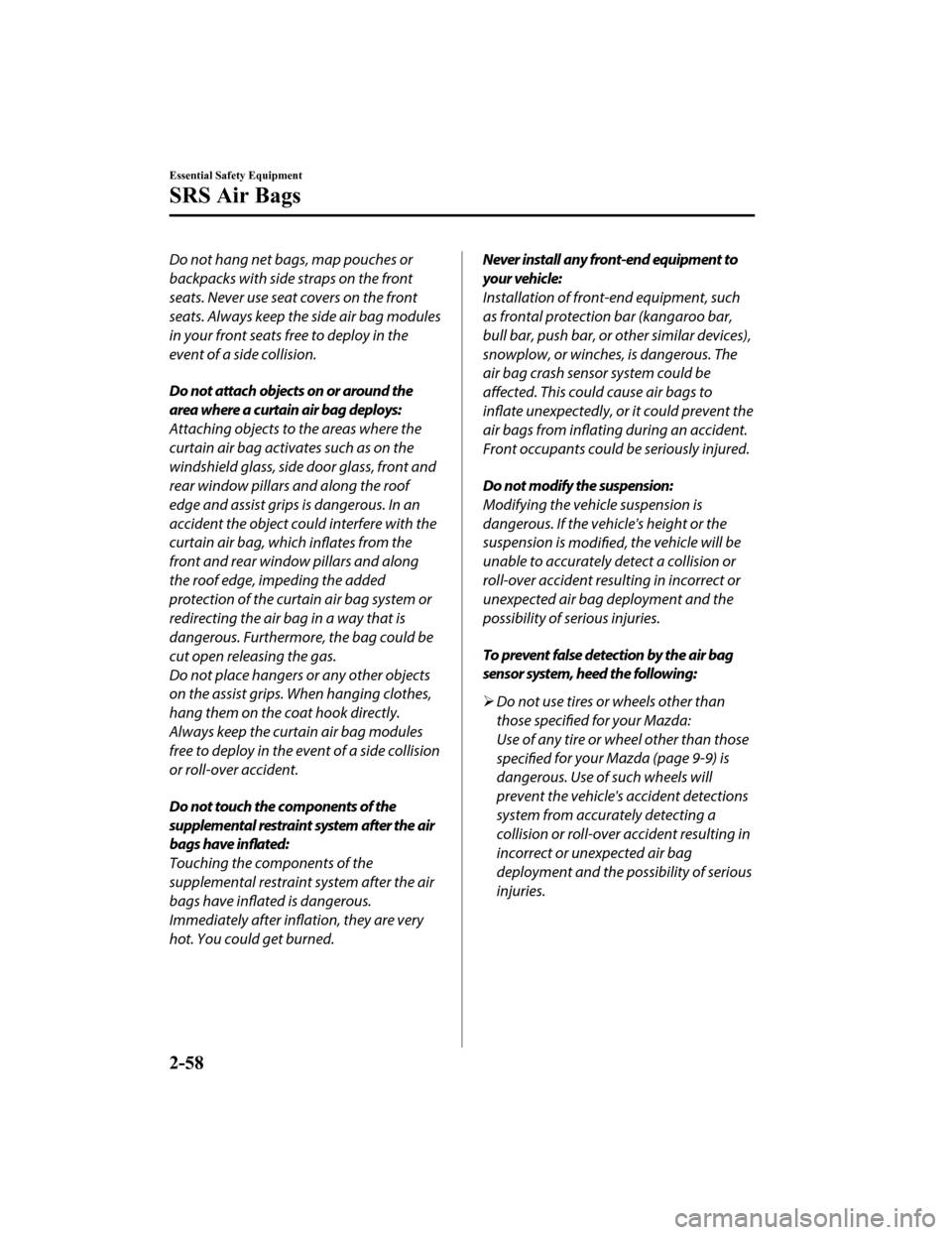
Do not hang net bags, map pouches or
backpacks with side straps on the front
seats. Never use seat covers on the front
seats. Always keep the side air bag modules
in your front seats free to deploy in the
event of a side collision.
Do not attach objects on or around the
area where a curtain air bag deploys:
Attaching objects to the areas where the
curtain air bag activates such as on the
windshield glass, side door glass, front and
rear window pillars and along the roof
edge and assist grips is dangerous. In an
accident the object could interfere with the
curtain air bag, which inflates from the
front and rear window pillars and along
the roof edge, impeding the added
protection of the curtain air bag system or
redirecting the air bag in a way that is
dangerous. Furthermore, the bag could be
cut open releasing the gas.
Do not place hangers or any other objects
on the assist grips. When hanging clothes,
hang them on the coat hook directly.
Always keep the curtain air bag modules
free to deploy in the event of a side collision
or roll-over accident.
Do not touch the components of the
supplemental restraint system after the air
bags have inflated:
Touching the components of the
supplemental restraint system after the air
bags have inflated is dangerous.
Immediately after inflation, they are very
hot. You could get burned.Never install any front-end equipment to
your vehicle:
Installation of front-end equipment, such
as frontal protection bar (kangaroo bar,
bull bar, push bar, or other similar devices),
snowplow, or winches, is dangerous. The
air bag crash sensor system could be
affected. This could cause air bags to
inflate unexpectedly, or it could prevent the
air bags from inflating during an accident.
Front occupants could be seriously injured.
Do not modify the suspension:
Modifying the vehicle suspension is
dangerous. If the vehi cle's height or the
suspension is modified, the vehicle will be
unable to accurately detect a collision or
roll-over accident resulting in incorrect or
unexpected air bag deployment and the
possibility of serious injuries.
To prevent false detection by the air bag
sensor system, heed the following:
Do not use tires or wheels other than
those
specified for your Mazda:
Use of any tire or wheel other than those specified for your Mazda (page 9-9) is
dangerous. Use of such wheels will
prevent the vehicle's accident detections
system from accurately detecting a
collision or roll-over accident resulting in
incorrect or unexpected air bag
deployment and the possibility of serious
injuries.
Essential Safety Equipment
SRS Air Bags
2-58
Mazda3_8HZ1-EA-19G_Edition1_old 2019-5-17 13:49:03
Page 76 of 598
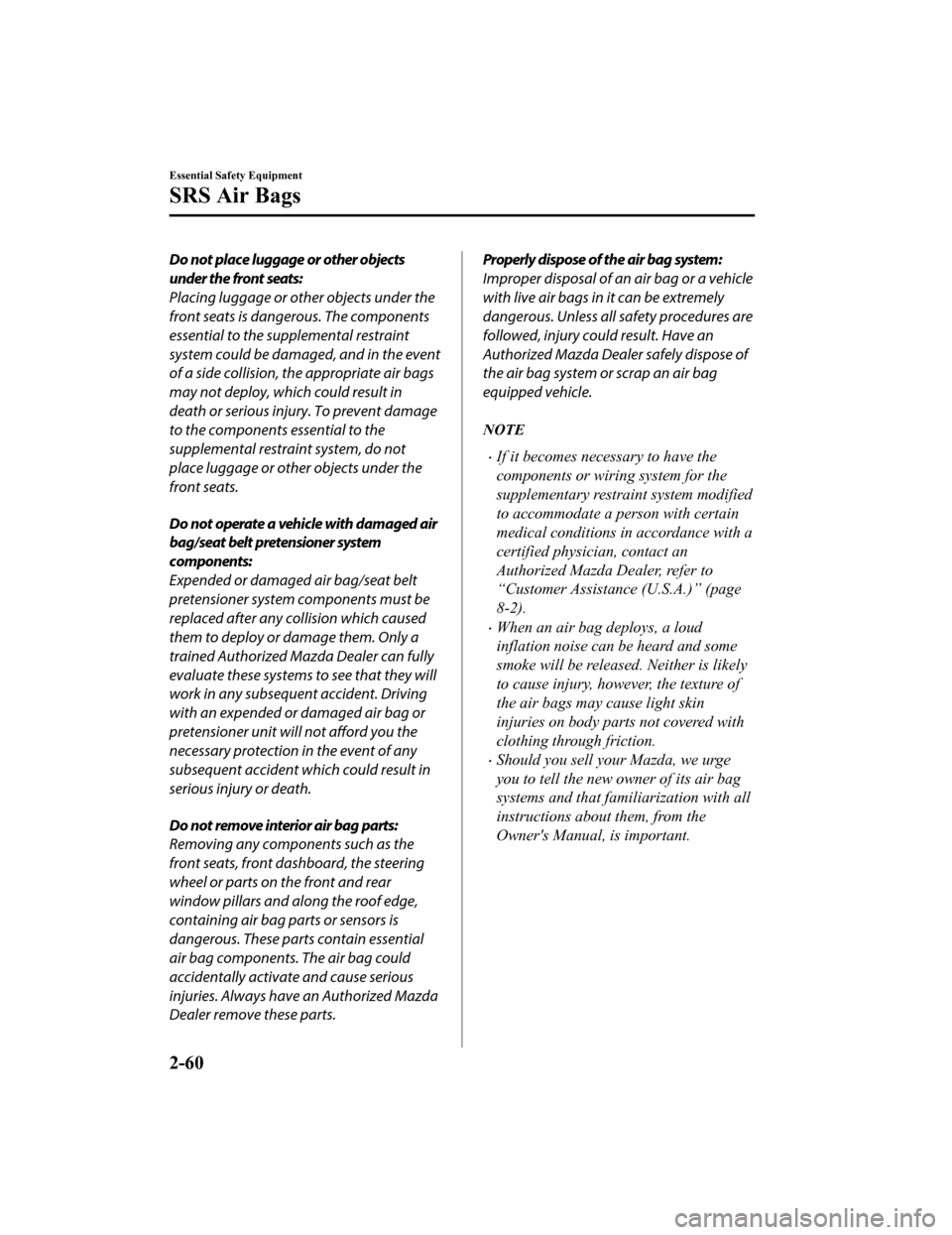
Do not place luggage or other objects
under the front seats:
Placing luggage or other objects under the
front seats is dangerous. The components
essential to the supplemental restraint
system could be damaged, and in the event
of a side collision, the appropriate air bags
may not deploy, which could result in
death or serious injury. To prevent damage
to the components essential to the
supplemental restraint system, do not
place luggage or other objects under the
front seats.
Do not operate a vehicle with damaged air
bag/seat belt pretensioner system
components:
Expended or damaged air bag/seat belt
pretensioner system components must be
replaced after any collision which caused
them to deploy or damage them. Only a
trained Authorized Mazda Dealer can fully
evaluate these systems to see that they will
work in any subsequent accident. Driving
with an expended or damaged air bag or
pretensioner unit will not afford you the
necessary protection in the event of any
subsequent accident which could result in
serious injury or death.
Do not remove interior air bag parts:
Removing any components such as the
front seats, front dashboard, the steering
wheel or parts on the front and rear
window pillars and al ong the roof edge,
containing air bag parts or sensors is
dangerous. These parts contain essential
air bag components. The air bag could
accidentally activate and cause serious
injuries. Always have an Authorized Mazda
Dealer remove these parts.Properly dispose of the air bag system:
Improper disposal of an air bag or a vehicle
with live air bags in it can be extremely
dangerous. Unless all safety procedures are
followed, injury could result. Have an
Authorized Mazda Deal er safely dispose of
the air bag system or scrap an air bag
equipped vehicle.
NOTE
If it becomes necessary to have the
components or wiring system for the
supplementary restraint system modified
to accommodate a person with certain
medical conditions in accordance with a
certified physician, contact an
Authorized Mazda Dealer, refer to
“Customer Assistance (U.S.A.)” (page
8-2).
When an air bag deploys, a loud
inflation noise can be heard and some
smoke will be released. Neither is likely
to cause injury, however, the texture of
the air bags may cause light skin
injuries on body parts not covered with
clothing through friction.
Should you sell your Mazda, we urge
you to tell the new owner of its air bag
systems and that familiarization with all
instructions about them, from the
Owner's Manual, is important.
Essential Safety Equipment
SRS Air Bags
2-60
Mazda3_8HZ1-EA-19G_Edition1_old 2019-5-17 13:49:03
Page 81 of 598
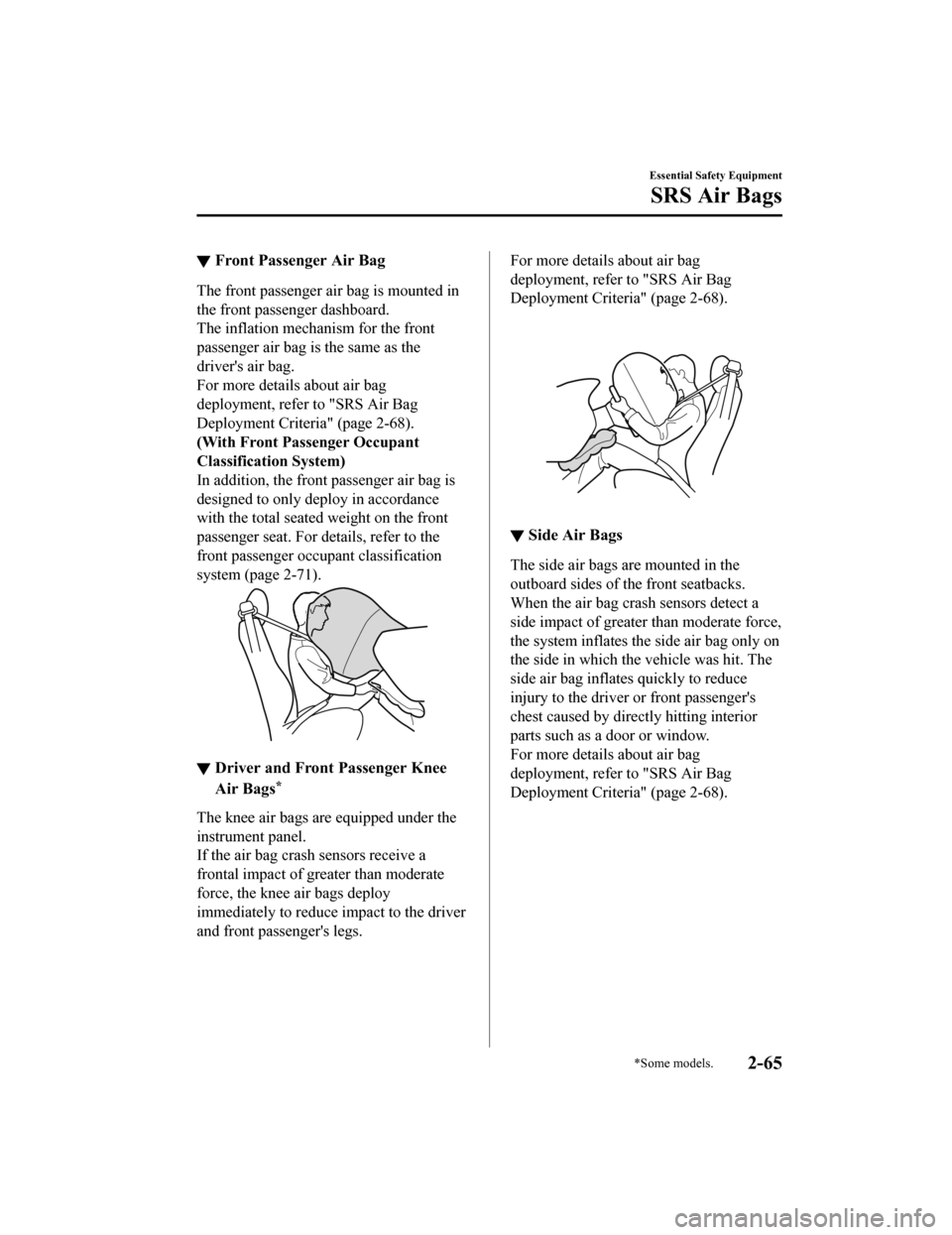
▼Front Passenger Air Bag
The front passenger air bag is mounted in
the front passenger dashboard.
The inflation mechanism for the front
passenger air bag is the same as the
driver's air bag.
For more details about air bag
deployment, refer to "SRS Air Bag
Deployment Crite
ria" (page 2-68).
(With Front Passenger Occupant
Classification System)
In addition, the front passenger air bag is
designed to only deploy in accordance
with the total seated weight on the front
passenger seat. For details, refer to the
front passenger occupant classification
system (page 2-71).
▼ Driver and Front Passenger Knee
Air Bags*
The knee air bags are equipped under the
instrument panel.
If the air bag crash
sensors receive a
frontal impact of greater than moderate
force, the knee air bags deploy
immediately to reduce impact to the driver
and front passenger's legs.
For more details about air bag
deployment, refer to "SRS Air Bag
Deployment Criteria" (page 2-68).
▼ Side Air Bags
The side air bags are mounted in the
outboard sides of the front seatbacks.
When the air bag crash sensors detect a
side impact of greater than moderate force,
the system inflates the side air bag only on
the side in which the vehicle was hit. The
side air bag inflates quickly to reduce
injury to the driver or front passenger's
chest caused by directly hitting interior
parts such as a door or window.
For more details about air bag
deployment, refer to "SRS Air Bag
Deployment Criteria" (page 2-68).
Essential Safety Equipment
SRS Air Bags
*Some models.2-65
Mazda3_8HZ1-EA-19G_Edition1_old
2019-5-17 13:49:03
Page 82 of 598
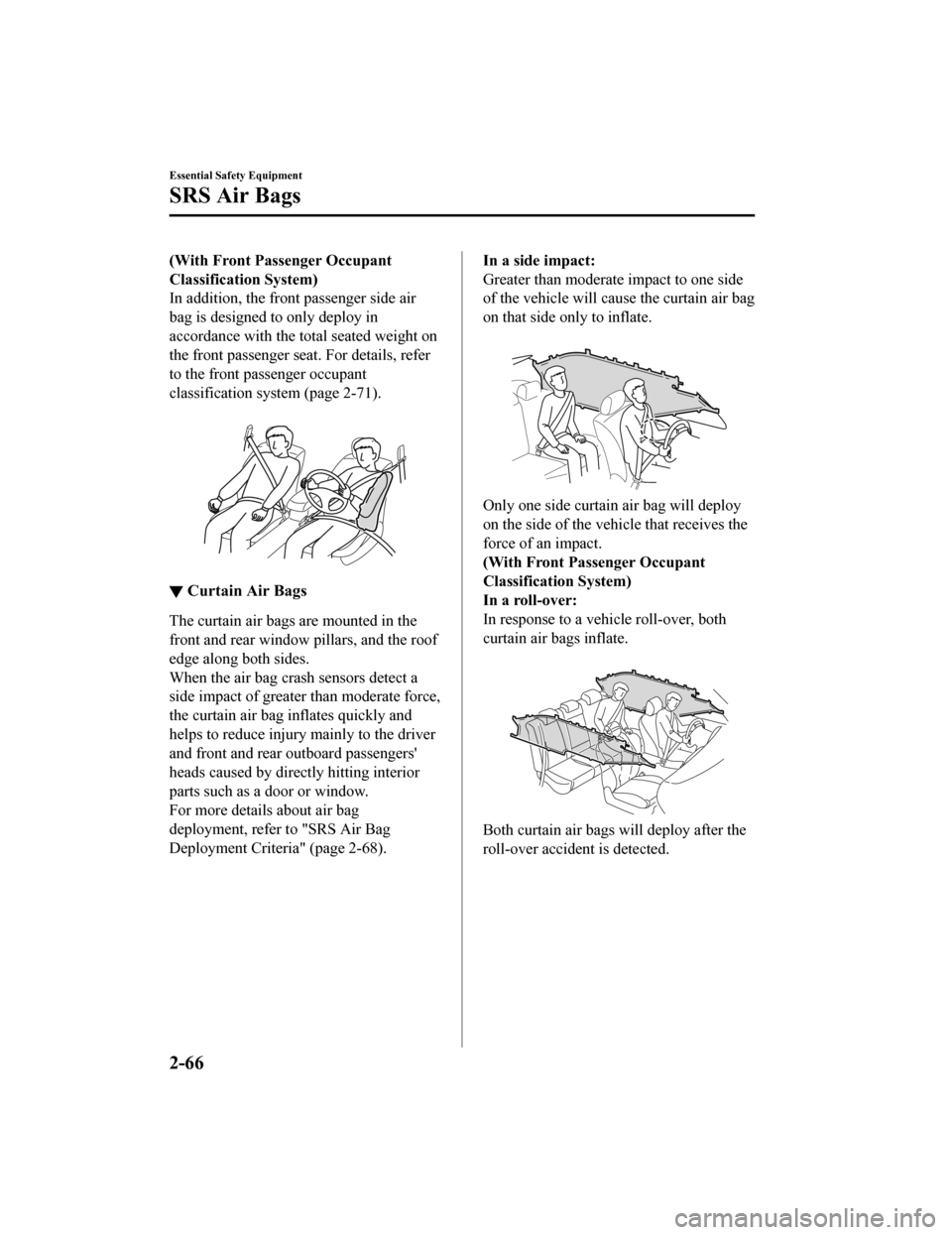
(With Front Passenger Occupant
Classification System)
In addition, the front passenger side air
bag is designed to only deploy in
accordance with the total seated weight on
the front passenger seat. For details, refer
to the front passenger occupant
classification system (page 2-71).
▼ Curtain Air Bags
The curtain air bags are mounted in the
front and rear window pillars, and the roof
edge along both sides.
When the air bag cra
sh sensors detect a
side impact of greater than moderate force,
the curtain air bag inflates quickly and
helps to reduce injury mainly to the driver
and front and rear outboard passengers'
heads caused by direct ly hitting interior
parts such as a door or window.
For more details about air bag
deployment, refer to "SRS Air Bag
Deployment Criteria" (page 2-68).
In a side impact:
Greater than moderate impact to one side
of the vehicle will cau se the curtain air bag
on that side only to inflate.
Only one side curtain air bag will deploy
on the side of the veh icle that receives the
force of an impact.
(With Front Passenger Occupant
Classification System)
In a roll-over:
In response to a vehicle roll-over, both
curtain air bags inflate.
Both curtain air bags will deploy after the
roll-over accident is detected.
Essential Safety Equipment
SRS Air Bags
2-66
Mazda3_8HZ1-EA-19G_Edition1_old 2019-5-17 13:49:03
Page 93 of 598
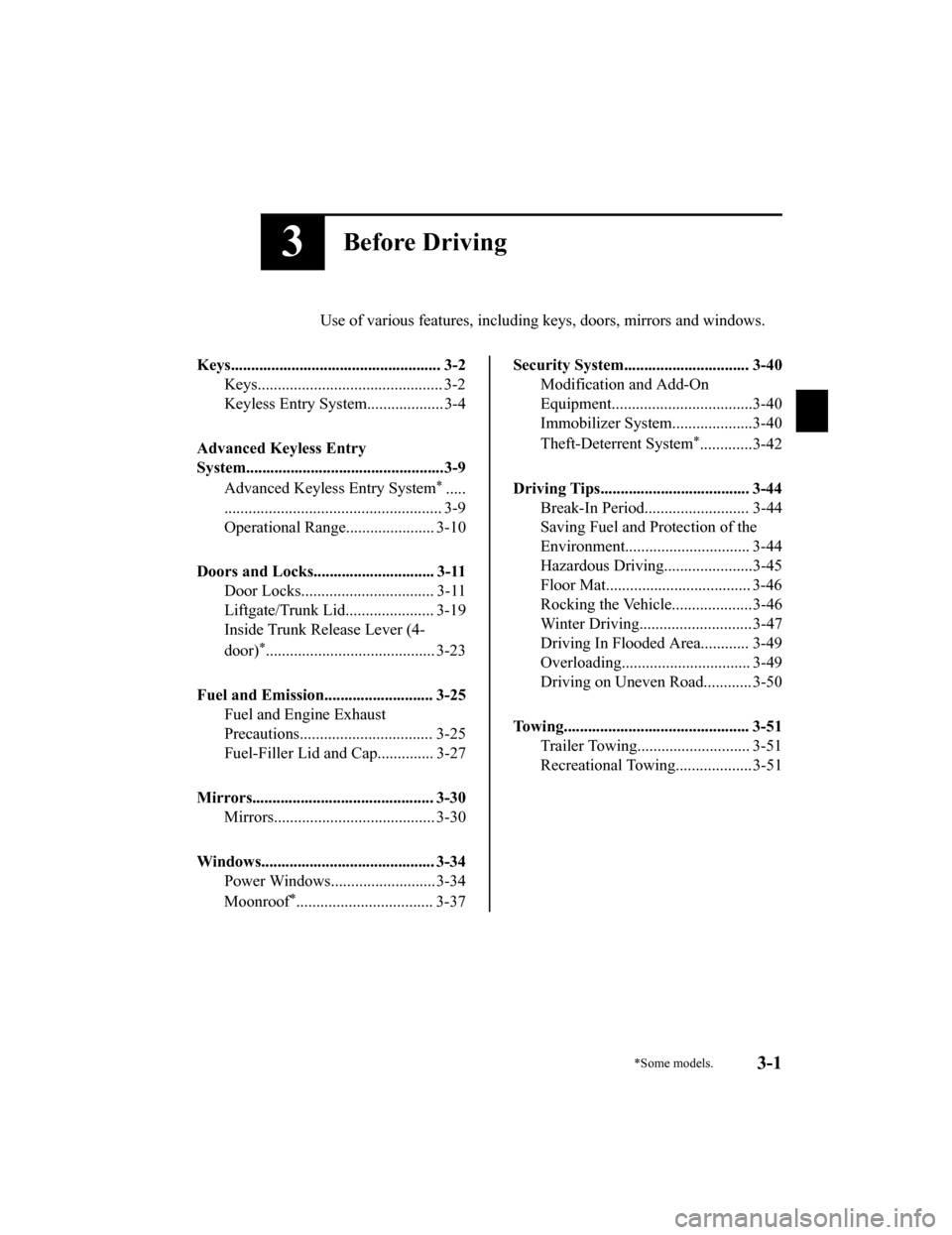
3Before Driving
Use of various features, including keys, doors, mirrors and windows.
Keys.................................................... 3-2 Keys.............................................. 3-2
Keyless Entry System................... 3-4
Advanced Keyless Entry
System.................................................3-9 Advanced Keyless Entry System
*.....
...................................................... 3-9
Operational Range...................... 3-10
Doors and Locks.............................. 3-11 Door Locks................................. 3-11
Liftgate/Trunk Lid...................... 3-19
Inside Trunk Release Lever (4-
door)
*.......................................... 3-23
Fuel and Emission........................... 3-25 Fuel and Engine Exhaust
Precautions................................. 3-25
Fuel-Filler Lid and Cap.............. 3-27
Mirrors............................................. 3-30 Mirrors........................................ 3-30
Windows........................................... 3-34 Power Windows..........................3-34
Moonroof
*.................................. 3-37
Security System............................... 3-40Modification and Add-On
Equipment...................................3-40
Immobilizer System....................3-40
Theft-Deterrent System
*.............3-42
Driving Tips..................................... 3-44 Break-In Period.......................... 3-44
Saving Fuel and Protection of the
Environment............................... 3-44
Hazardous Driving.... ..................3-45
Floor Mat.................................... 3-46
Rocking the Vehicle....................3-46
Winter Driving............................3-47
Driving In Flooded A rea............ 3-49
Overloading................................ 3-49
Driving on Uneven Road............ 3-50
Towing.............................................. 3-51 Trailer Towing............................ 3-51
Recreational Towing................... 3-51
*Some models.3-1
Mazda3_8HZ1-EA-19G_Edition1_old 2019-5-17 13:49:03
Page 94 of 598
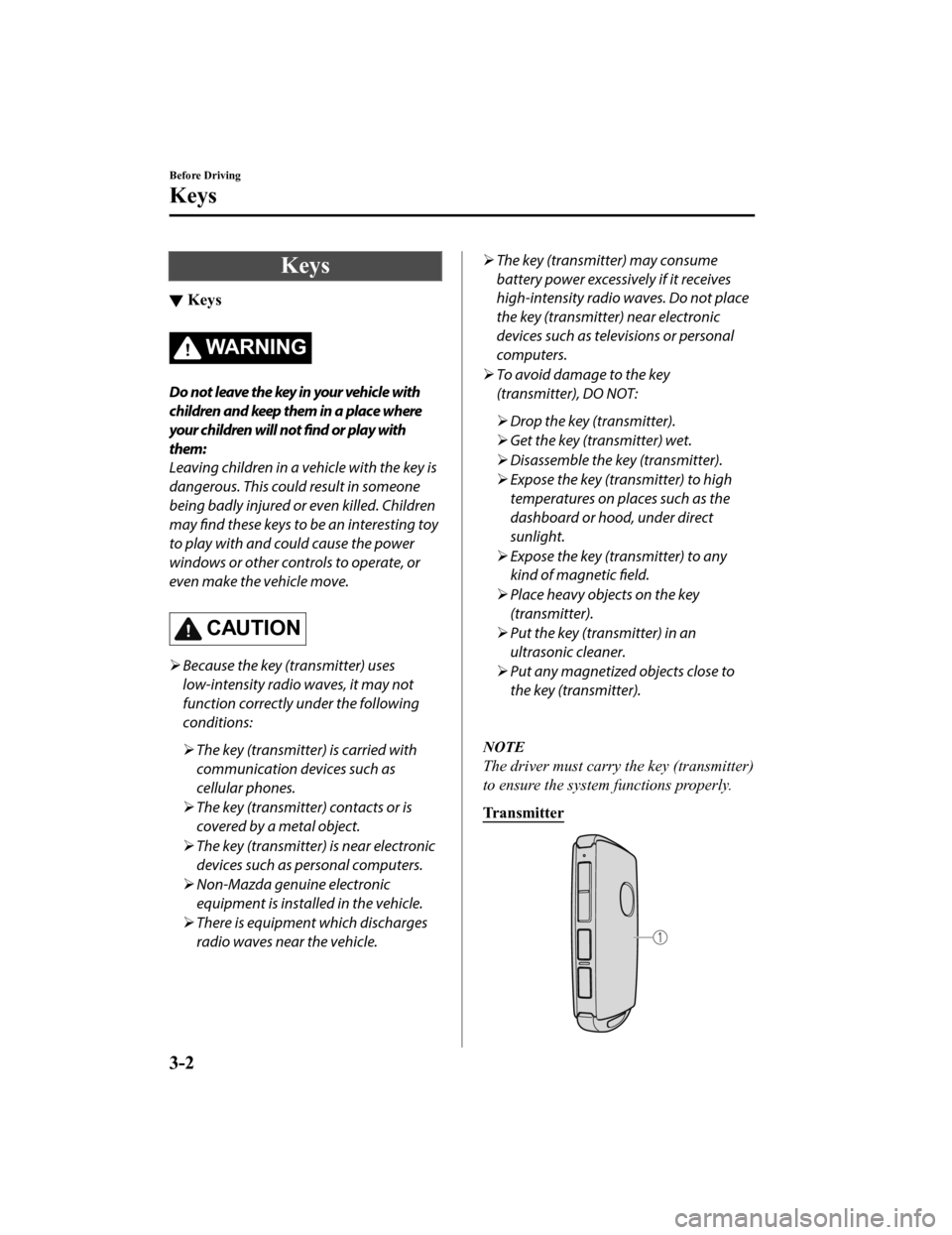
Keys
▼Keys
WA R N I N G
Do not leave the key in your vehicle with
children and keep them in a place where
your children will not
find or play with
them:
Leaving children in a vehicle with the key is
dangerous. This could result in someone
being badly injured or even killed. Children
may find these keys to be an interesting toy
to play with and could cause the power
windows or other controls to operate, or
even make the vehicle move.
CAUTION
Because the key (transmitter) uses
low-intensity radio waves, it may not
function correctly under the following
conditions:
The key (transmitter) is carried with
communication devices such as
cellular phones.
The key (transmitter) contacts or is
covered by a metal object.
The key (transmitter) is near electronic
devices such as personal computers.
Non-Mazda genuine electronic
equipment is installed in the vehicle.
There is equipment which discharges
radio waves near the vehicle.
The key (transmitter) may consume
battery power excessively if it receives
high-intensity radio waves. Do not place
the key (transmitter) near electronic
devices such as tele visions or personal
computers.
To avoid damage to the key
(transmitter), DO NOT:
Drop the key (transmitter).
Get the key (transmitter) wet.
Disassemble the key (transmitter).
Expose the key (transmitter) to high
temperatures on places such as the
dashboard or hood, under direct
sunlight.
Expose the key (transmitter) to any
kind of magnetic field.
Place heavy objects on the key
(transmitter).
Put the key (transmitter) in an
ultrasonic cleaner.
Put any magnetized objects close to
the key (transmitter).
NOTE
The driver must carry the key (transmitter)
to ensure the system functions properly.
Transmitter
Before Driving
Keys
3-2
Mazda3_8HZ1-EA-19G_Edition1_old 2019-5-17 13:49:03
Page 99 of 598
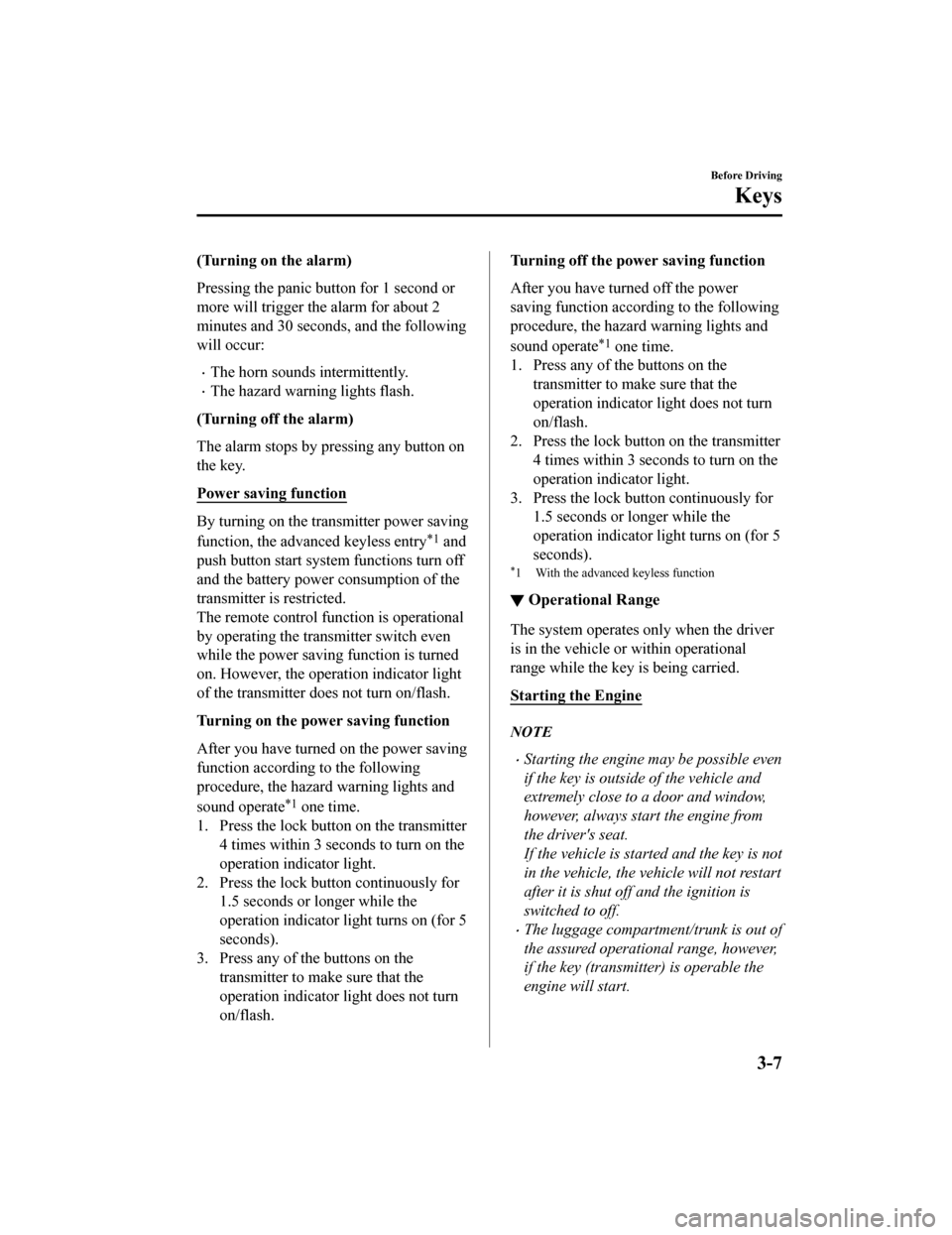
(Turning on the alarm)
Pressing the panic button for 1 second or
more will trigger the alarm for about 2
minutes and 30 seconds, and the following
will occur:
The horn sounds intermittently.
The hazard warning lights flash.
(Turning off the alarm)
The alarm stops by pressing any button on
the key.
Power saving function
By turning on the transmitter power saving
function, the advan ced keyless entry
*1 and
push button start system functions turn off
and the battery power consumption of the
transmitter is restricted.
The remote control function is operational
by operating the transmitter switch even
while the power saving function is turned
on. However, the operation indicator light
of the transmitter does not turn on/flash.
Turning on the power saving function
After you have turned on the power saving
function according to the following
procedure, the hazard warning lights and
sound operate
*1 one time.
1. Press the lock button on the transmitter 4 times within 3 seconds to turn on the
operation indicator light.
2. Press the lock button continuously for 1.5 seconds or longer while the
operation indicator light turns on (for 5
seconds).
3. Press any of the buttons on the
transmitter to make sure that the
operation indicator light does not turn
on/flash.
Turning off the power saving function
After you have turned off the power
saving function according to the following
procedure, the hazard warning lights and
sound operate
*1 one time.
1. Press any of the buttons on the
transmitter to make sure that the
operation indicator light does not turn
on/flash.
2. Press the lock button on the transmitter 4 times within 3 seconds to turn on the
operation indicator light.
3. Press the lock button continuously for 1.5 seconds or longer while the
operation indicator light turns on (for 5
seconds).
*1 With the advanced keyless function
▼Operational Range
The system operates only when the driver
is in the vehicle or
within operational
range while the key is being carried.
Starting the Engine
NOTE
Starting the engine may be possible even
if the key is outside of the vehicle and
extremely close to a door and window,
however, always start the engine from
the driver's seat.
If the vehicle is started and the key is not
in the vehicle, the vehicle will not restart
after it is shut off and the ignition is
switched to off.
The luggage compartment/trunk is out of
the assured operational range, however,
if the key (transmitter) is operable the
engine will start.
Before Driving
Keys
3-7
Mazda3_8HZ1-EA-19G_Edition1_old 2019-5-17 13:49:03
Page 102 of 598
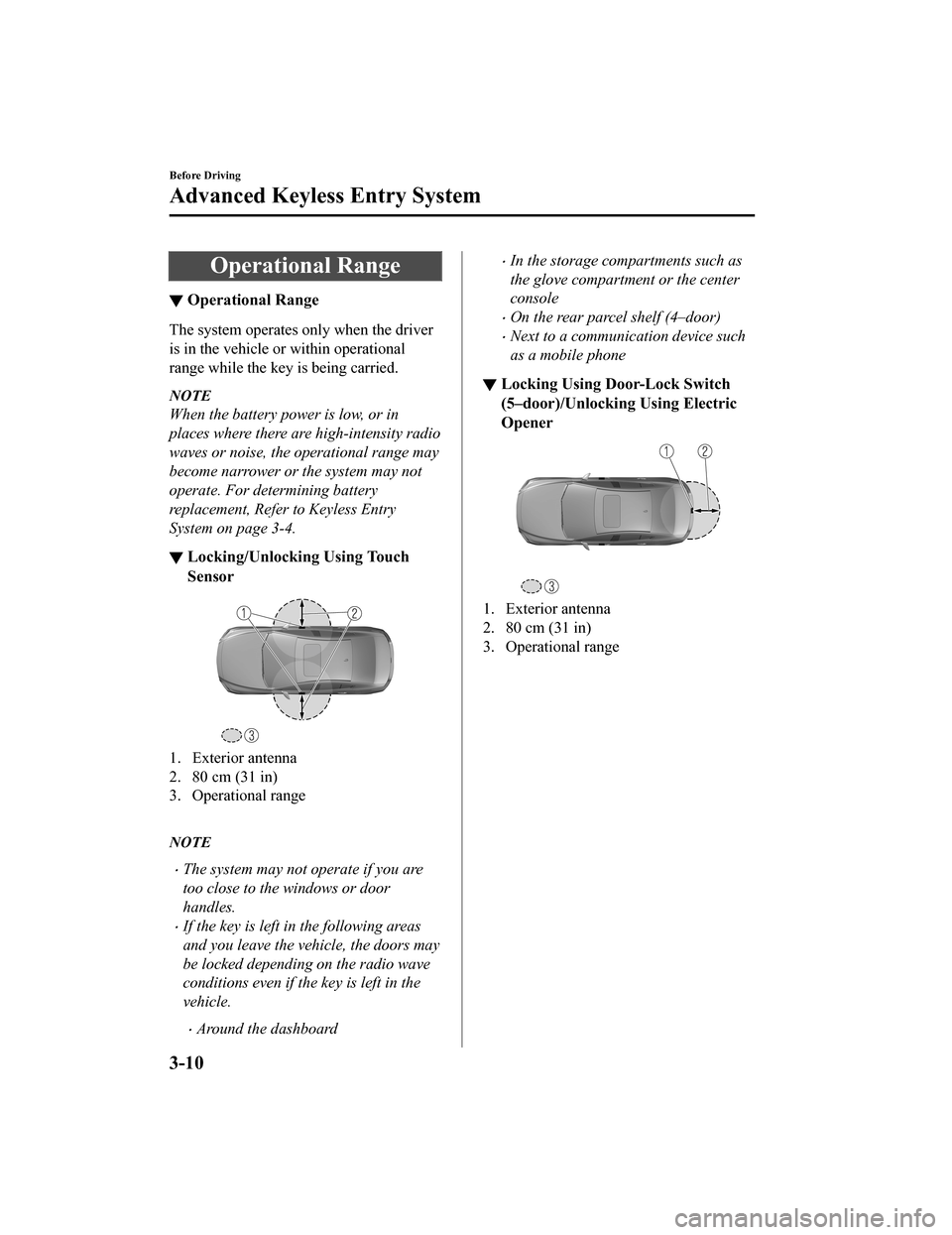
Operational Range
▼Operational Range
The system operates only when the driver
is in the vehicle or within operational
range while the key is being carried.
NOTE
When the battery power is low, or in
places where there are high-intensity radio
waves or noise, the operational range may
become narrower or the system may not
operate. For determining battery
replacement, Refer to Keyless Entry
System on page 3-4.
▼Locking/Unlocking Using Touch
Sensor
1. Exterior antenna
2. 80 cm (31 in)
3. Operational range
NOTE
The system may not operate if you are
too close to the windows or door
handles.
If the key is left in the following areas
and you leave the vehicle, the doors may
be locked depending on the radio wave
conditions even if the key is left in the
vehicle.
Around the dashboard
In the storage compartments such as
the glove compartment or the center
console
On the rear parcel shelf (4–door)
Next to a communication device such
as a mobile phone
▼ Locking Using Door-Lock Switch
(5–door)/Unlocking Using Electric
Opener
1. Exterior antenna
2. 80 cm (31 in)
3. Operational range
Before Driving
Advanced Keyless Entry System
3-10
Mazda3_8HZ1-EA-19G_Edition1_old
2019-5-17 13:49:03
Page 103 of 598
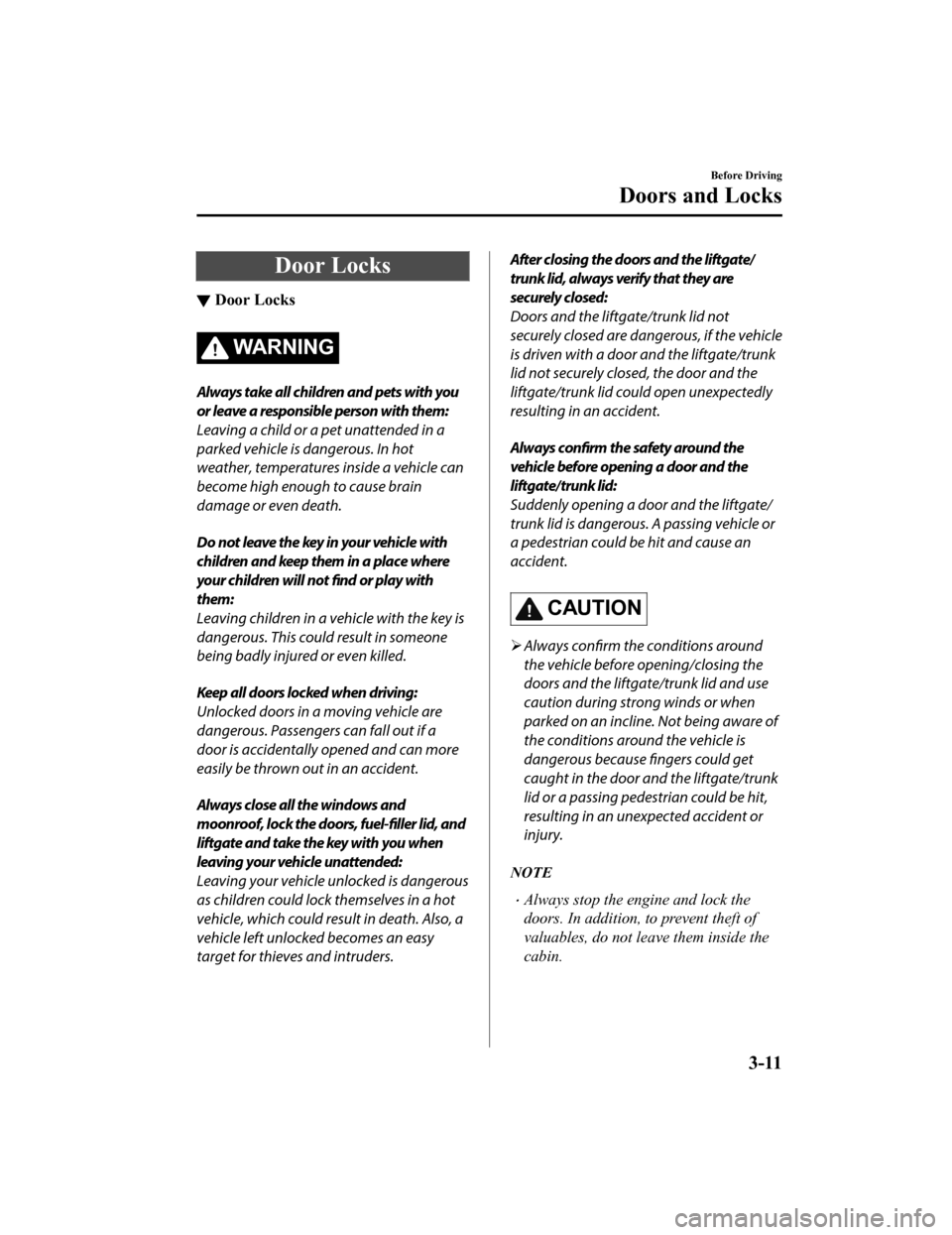
Door Locks
▼Door Locks
WA R N I N G
Always take all children and pets with you
or leave a responsible person with them:
Leaving a child or a pet unattended in a
parked vehicle is dangerous. In hot
weather, temperatures inside a vehicle can
become high enough to cause brain
damage or even death.
Do not leave the key in your vehicle with
children and keep them in a place where
your children will not find or play with
them:
Leaving children in a vehicle with the key is
dangerous. This could result in someone
being badly injured or even killed.
Keep all doors locked when driving:
Unlocked doors in a moving vehicle are
dangerous. Passengers can fall out if a
door is accidentally opened and can more
easily be thrown out in an accident.
Always close all the windows and
moonroof, lock the doors, fuel-filler lid, and
liftgate and take the key with you when
leaving your vehicle unattended:
Leaving your vehicle unlocked is dangerous
as children could lock themselves in a hot
vehicle, which could result in death. Also, a
vehicle left unlocked becomes an easy
target for thieves and intruders.
After closing the doors and the liftgate/
trunk lid, always verify that they are
securely closed:
Doors and the liftgate/trunk lid not
securely closed are dangerous, if the vehicle
is driven with a door and the liftgate/trunk
lid not securely closed, the door and the
liftgate/trunk lid could open unexpectedly
resulting in an accident.
Always confirm the safety around the
vehicle before opening a door and the
liftgate/trunk lid:
Suddenly opening a door and the liftgate/
trunk lid is dangerous. A passing vehicle or
a pedestrian could be hit and cause an
accident.
CAUTION
Always confirm the conditions around
the vehicle before opening/closing the
doors and the liftgate/trunk lid and use
caution during strong winds or when
parked on an incline. Not being aware of
the conditions around the vehicle is
dangerous because fingers could get
caught in the door and the liftgate/trunk
lid or a passing pedestrian could be hit,
resulting in an unexpected accident or
injury.
NOTE
Always stop the engine and lock the
doors. In addition, to prevent theft of
valuables, do not leave them inside the
cabin.
Before Driving
Doors and Locks
3-11
Mazda3_8HZ1-EA-19G_Edition1_old 2019-5-17 13:49:03